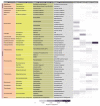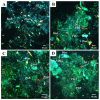Community Vertical Composition of the Laguna Negra Hypersaline Microbial Mat, Puna Region (Argentinean Andes)
- PMID: 35741352
- PMCID: PMC9220024
- DOI: 10.3390/biology11060831
Community Vertical Composition of the Laguna Negra Hypersaline Microbial Mat, Puna Region (Argentinean Andes)
Abstract
The Altiplano-Puna region is a high-altitude plateau in South America characterized by extreme conditions, including the highest UV incidence on Earth. The Laguna Negra is a hypersaline lake located in the Catamarca Province, northwestern Argentina, where stromatolites and other microbialites are found, and where life is mostly restricted to microbial mats. In this study, a particular microbial mat that covers the shore of the lake was explored, to unravel its layer-by-layer vertical structure in response to the environmental stressors therein. Microbial community composition was assessed by high-throughput 16S rRNA gene sequencing and pigment content analyses, complemented with microscopy tools to characterize its spatial arrangement within the mat. The top layer of the mat has a remarkable UV-tolerance feature, characterized by the presence of Deinococcus-Thermus and deinoxanthin, which might reflect a shielding strategy to cope with high UV radiation. Chloroflexi and Deltaproteobacteria were abundant in the second and third underlying layers, respectively. The bottom layer harbors copious Halanaerobiaeota. Subspherical aggregates composed of calcite, extracellular polymeric substances, abundant diatoms, and other microorganisms were observed all along the mat as the main structural component. This detailed study provides insights into the strategies of microbial communities to thrive under high UV radiation and hypersalinity in high-altitude lakes in the Altiplano-Puna region.
Keywords: Andes; Puna region; UV radiation; extreme environment; high-altitude; hypersaline lake; microbial diversity; pigments.
Conflict of interest statement
The authors declare no conflict of interest.
Figures









Similar articles
-
Characterization of Pustular Mats and Related Rivularia-Rich Laminations in Oncoids From the Laguna Negra Lake (Argentina).Front Microbiol. 2018 May 22;9:996. doi: 10.3389/fmicb.2018.00996. eCollection 2018. Front Microbiol. 2018. PMID: 29872427 Free PMC article.
-
The discovery of stromatolites developing at 3570 m above sea level in a high-altitude volcanic lake Socompa, Argentinean Andes.PLoS One. 2013;8(1):e53497. doi: 10.1371/journal.pone.0053497. Epub 2013 Jan 7. PLoS One. 2013. PMID: 23308236 Free PMC article.
-
Stratified Bacterial Diversity along Physico-chemical Gradients in High-Altitude Modern Stromatolites.Front Microbiol. 2017 Apr 12;8:646. doi: 10.3389/fmicb.2017.00646. eCollection 2017. Front Microbiol. 2017. PMID: 28446906 Free PMC article.
-
Lithifying and Non-Lithifying Microbial Ecosystems in the Wetlands and Salt Flats of the Central Andes.Microb Ecol. 2022 Jan;83(1):1-17. doi: 10.1007/s00248-021-01725-8. Epub 2021 Mar 17. Microb Ecol. 2022. PMID: 33730193 Review.
-
Extant Earthly Microbial Mats and Microbialites as Models for Exploration of Life in Extraterrestrial Mat Worlds.Life (Basel). 2021 Aug 27;11(9):883. doi: 10.3390/life11090883. Life (Basel). 2021. PMID: 34575032 Free PMC article. Review.
Cited by
-
Vertical organization of microbial communities in Salineta hypersaline wetland, Spain.Front Microbiol. 2023 Jan 27;14:869907. doi: 10.3389/fmicb.2023.869907. eCollection 2023. Front Microbiol. 2023. PMID: 36778872 Free PMC article.
-
Exploring Soil Bacterial Diversity in Relation to Edaphic Physicochemical Properties of High-altitude Wetlands from Argentine Puna.Microb Ecol. 2023 Nov 30;87(1):6. doi: 10.1007/s00248-023-02316-5. Microb Ecol. 2023. PMID: 38030916
-
Microbial and Geochemical Diversity of Laguna Timone, an Extreme Hypersaline Crater Lake in Patagonia (52° S).Microorganisms. 2025 Aug 21;13(8):1957. doi: 10.3390/microorganisms13081957. Microorganisms. 2025. PMID: 40871462 Free PMC article.
References
-
- Franks J., Stolz J.F. Flat laminated microbial mat communities. Earth-Sci. Rev. 2009;96:163–172. doi: 10.1016/j.earscirev.2008.10.004. - DOI
-
- Gerdes G. What Are Microbial Mats? In: Seckbach J., Oren A., editors. Microbial Mats: Modern and Ancient Microorganisms in Stratified Systems. 1st ed. Springer Science & Business Media B.V.; Dordrecht, The Netherlands: 2010. pp. 5–25.
-
- Prieto-Barajas C.M., Valencia-Cantero E., Santoyo G. Microbial mat ecosystems: Structure types, functional diversity, and biotechnological application. Electron. J. Biotechnol. 2018;31:48–56. doi: 10.1016/j.ejbt.2017.11.001. - DOI
-
- Seckbach J., Oren A. Microbial Mats: Modern and Ancient Microorganisms in Stratified Systems. 1st ed. Springer Science & Business Media B.V.; Dordrecht, The Netherlands: 2010. pp. 389–539.
LinkOut - more resources
Full Text Sources

